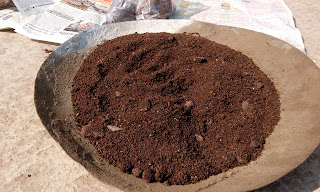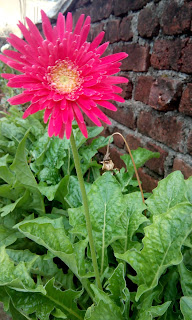Hi Everyone,
I went through several website to get the recipe for the perfect potting mix. After several researches I came along some ingredients which when mixed in a ratio results in a healthy potting mix.
Potting mix is the most important thing for the plants. Some important characteristics that a potting mix should have are listed in the subsequent lines. The potting mix should be able to hold water and at the same time it should drain out excessive water. It should be rich in nutrients and to be specific NPK. Nitrogen , phosphorus and potassium are the basic building blocks for the garden to flourish, but at the same time the soil should contain some micro nutrients like zinc, calcium, boron magnesium and the list goes on. Another characteristic of the potting soil is porosity not only in terms of water but also proper air circulation must be present to help the roots breath. Besides porosity, the potting mix must be light. Nutrient rich soil helps the plants grow healthy and a healthy plant is not prone to the attack of pests and diseases. Adding all these characteristics together results into a healthy growing garden and happy plants.
Soil is the most readily available potting mix but at the same time it does not contain all these important characteristics. Hence we need to add certain commonly found ingredients. The quality of soil varies from one place to another. Somewhere the soil is porous and somewhere the soil is non porous. We generally spend a lot of money on buying soil conditioners and various other soil nutrient enhancers. Though these commercial products are beneficial. But still they do not meet all the requirements.
So friends I would like to share my experience on potting mix. Though this might not be the perfect one but still you may give it a try.
The ingredients that I use are listed below along with their benefits:
- Soil - The basic building block of the potting mix.
- Cow dung manure - This is one of the best and cheapest way to introduce organic matter to the soil. It increases the porosity and nutrient content of the soil. The cow dung manure also contains beneficial bacteria that helps build up the nitrogen cycle in the soil and slowly realease the nitrogen into the soil.But make sure you use dried cow dung so as to avoid introducing pathogens and other harmful organisms to the soil.
- Organic compost - you may either set your own compost bin and reduce the organic kitchen wastes or you may buy them from local stores. These composts also helps increasing the porosity and nutrient content of the soil.
- Vermicompost - vermicompost are rich in organic matter. It's nutrient content is very high. You may set up your own vermicompost bin or buy them from your local stores.
- Neem cakes - neem cakes helps reduce the soil born diseases and also repeals pest attacks on the plant. It acts like a natural pesticide.
- Mustard cakes - mustard cakes also helps reduce pest attacks. It adds to the immunity of the plant and helps it to fight diseases and pests.
- Dried leaf mulch or leaf compost - This is another better way to increase the porosity of the plant and add more organic matter to the soil. Adding leaf mulch to the top soil helps reduce weeds in the garden.
Add all these ingredients in equal ratio. If the potting mix needs to be acidic then add more acidic ingredients like cow dung manure, leaf compost and compost and if the soil needs to be alkaline then just add some coal or wood ash.
Below are some of the snaps from my garden on this experiment
 |
| My potting mix which will be added to the soil |
 |
| Adding the neem cakes |
 |
| Adding the compost |
 |
| Adding the mustard cake |
 |
| Vermicompost |
 |
| soil and cow dung manure |
I would also like to share the results I received after amending the soil with all of these
I hope this post was beneficial for you. You may give it a try on your own and kindly correct me if I mentioned something wrong. Hope to join you all soon in my next post. Till then happy Gardening !













Now I know the secret of your garden beauties. We have tried the above mixture except for the vermicompost and mustard cakes. This post is definitely beneficial to all like me. How do you know whether the mixture is acidic or alkaline? Could you please throw some light on this?
ReplyDeleteHi Vasudha,
ReplyDeleteThere are several commercial indicators sold in the market, they will definitely help you map your soil pH level. But I don't use them.
Plants like roses, azaleas like acidic soil hence i increase the acidic ingredients compositions like adding more cow dung manure and compost. Cow dung manure is acidic in nature and adds a lot of organic matter to the soil. To ensure that your soil has to be more acidic you may go for compost tea which is generally made by just mixing the cow dung in water, and let it be there for a week, just give it a steer and spray the same on to the plants and this will help the soil maintain its pH level. or else you may go with adding cow dung manure to the soil in a frequent intervals...may be once a month to maintain the pH level. If you have access to chicken manure..then this is the best way to increase the acidity of the soil. but chicken manure should not be added in huge quantity, make sure you just add fist full of it per container.
Plants like mums love alkaline soil. Coal ash or wood ash are the best sources for increasing the alkalinity of your soil. They are rich in potash content.
Adding cow dung manure, compost basically increases the soil content slightly and if you add more of it it will increase the acidity in the soil. hence to increase the alkalinity you may just slightly reduce the cow dung manure and compost (but definitely these are useful for all types of plants) content and add some ash to the soil.
I have got all these stuffs and knowledge from around various websites and they definitely work for me. Hope this helps you. and thank you for your valuable comments.